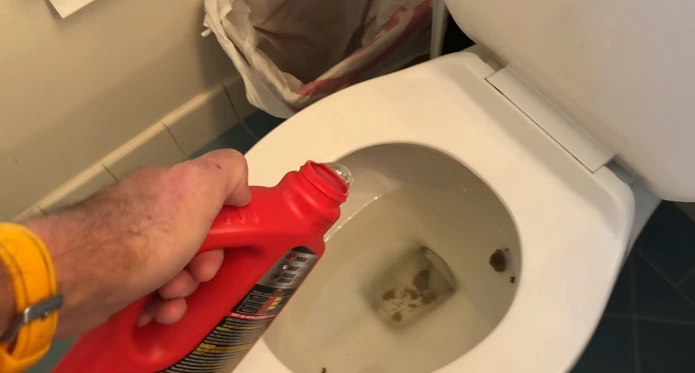Last Updated on November 14, 2023
Are you tired of dealing with clogged toilet drainage pipes that just won’t seem to let go? Before you call the plumber, it may be worth trying the drain cleaner.
You might be able to unclog your toilet using enzyme-based drain cleaner, an effective weapon many homeowners whip out when plumbing woes threaten their peace.
When your toilet pipe is clogged, you want to reach for a bottle of chemical drain cleaner. But while it is highly effective in clearing stubborn blockages, it also carries potential risks and drawbacks. If not used properly, these chemicals could leave costly plumbing repairs at stake, as they can wreak havoc on your piping system.
Discover how to use these cleaners, how they work, and what precautions you should take. Find out if using them involves any risk, so you will have all your questions answered whether you encounter drainage problems.
How Can You Put Drain Cleaner in a Toilet: Unclogging Pipes
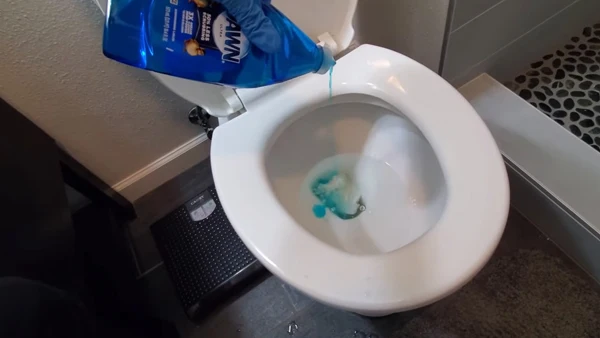
If you’re dealing with a clogged toilet or pipe, enzyme-based drain cleaners are your go-to solution. To ensure they don’t do more harm than good, it’s essential to use them correctly. Follow these simple steps for safe and successful descaling:
Step 01. Put On Protective Gear
Always wear protective gear such as goggles, gloves, and an apron when using drain cleaners. This will protect you against any splashes that may occur while pouring or mixing the solution. Also, ensure that other people in the area wear safety equipment to prevent accidents.
Step 02. Identify Clog Source & Location
To identify what type of clog has formed in your toilet or pipe, it is best to use a drain snake or toilet auger. A plumbing snake or auger should be used for this task since it will help you pinpoint exactly where the blockage is located and allow you to reach it more quickly than other methods.
Once you have identified the source of the clog, it is time to move on to the next step, measuring out the drain cleaner.
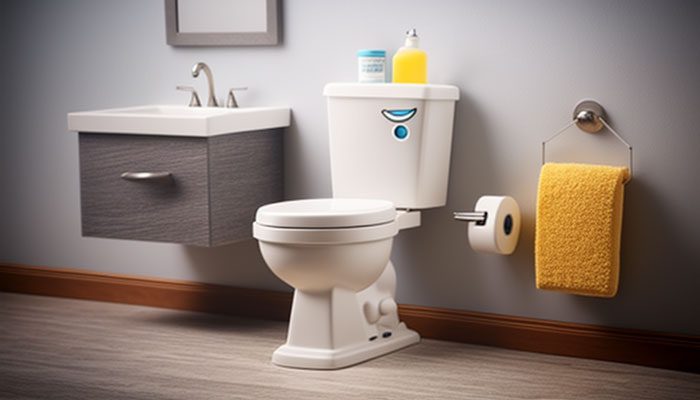
Step 03. Measure Drain Cleaner
Before adding any cleaner to your pipe system, measuring the correct amount for the job at hand is essential. The exact amount of product needed depends on manufacturer instructions and how severe the toilet clog is.
Generally, start using 1 cup of drain cleaning solution per 1 gallon of water in a standard-sized pipe system (check product specifications). It is also important not to mix different types of cleaners as this can form dangerous fumes, which could be hazardous if inhaled directly by humans or pets.
Step 04. Prepare Liquid Mixture
Once you have measured your desired cleaning solution, mix it with warm water in a bucket before pouring it into the affected area. For example, when working with a sink clogged with food residue, start by filling up 2/3rds of a bucket with warm water and then pour the drain cleaner into the mixture.
Remember, never mix different drain cleaners as this could have dangerous results, such as toxic fumes, corrosive liquids, or hazardous explosions due to chemical reactions.
Step 05. Pour Into Toilet Bowl
Pour the chosen cleaning solution into the toilet bowl and allow it to travel down into drains below to unclog any blockages caused by stubborn build-up or debris. Some products may require that toilet bowl water be flushed after the initial pour to activate the chemical reaction necessary for dissolving blockage if present.
Step 06. Allow Time To React
Once you have poured the drain cleaner into the toilet bowl, it is essential to leave it undisturbed for some time (at least 10 minutes) so that the chemical can work its magic on whatever clog might be present.
Depending on what kind of drain cleaner you are using, this may take anywhere from 10 minutes to a few hours before you can safely flush it away. Keep an eye on your progress, as some brands of drain cleaners may need additional applications if they aren’t doing their job correctly.
Also, be aware that different blockages require time to clear appropriately.
Step 07. Flush Toilet After Cleaning
After enough time has passed, it is time for you to flush away any remaining residue from your pipes and complete the process. Ensure that all protective equipment has been securely removed beforehand and any remaining fluid from containers used earlier in this process so as not to cause any further problems.
What Happens When You Put Drain Cleaner in Toilet Pipes?

A chemical reaction occurs when you put drain cleaner in toilet pipes for unclogging. This reaction releases heat and chlorine gas which helps dissolve the clog. The heat from the reaction also helps to loosen any debris or other materials blocking the drain.
Also, the chlorine gas in the drain cleaner kills any bacteria or microorganisms, or insects causing blockages. This combination of heat, chlorine, and bacteria-killing power makes drain cleaners an effective tool for unclogging toilets and drains.
In some cases, putting drain cleaner into a toilet helps reduce smells caused by bacteria and other organic matter caught in the pipe. Sulfuric acid can help kill bacteria and further break down the material, reducing odors.
Although it is possible to use a drain cleaner to help unclog toilets and drains, it is essential to use them cautiously. Most drain cleaners contain harsh chemicals which can damage pipes if not used correctly.
Pros of Using an Enzyme-Based Drain Cleaner in a Toilet

Enzyme-based drain cleaners break down organic matter and help prevent buildup that can cause blockages, making them more effective than chemical alternatives. Here are some in-depth advantages of using an enzyme-based drain cleaner in toilets.
Easy to Utilize
Using an enzyme-based drain cleaner is straightforward and requires no special tools or equipment. It can be poured directly into the toilet bowl or added directly to the plumbing system through the drain line with just a few simple steps.
The application process is quick and easy, allowing users to get the job done quickly without hassle. Also, because enzymes work slowly and gradually over time, there is no need for regular maintenance or cleaning. The enzymes will do all the work!
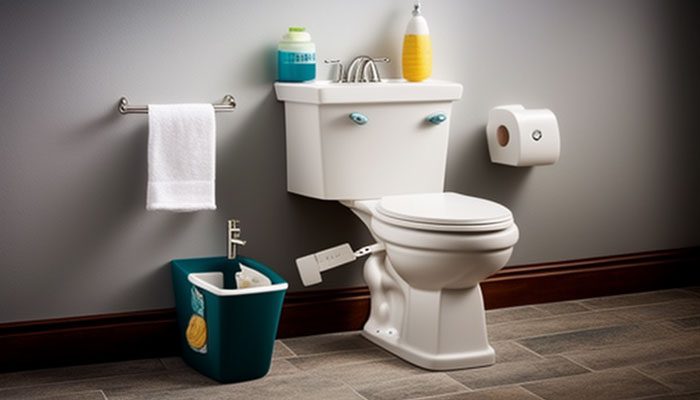
Inexpensive
Enzyme-based drain cleaners are affordable compared to other types on the market today. Various brands offer different sizes and concentrations of enzymes at different price points, so users can find one that fits their budget without compromising on quality or effectiveness.
This makes it an excellent option for those who want an effective solution without spending too much money. Since enzyme-based drain cleaners don’t contain toxic chemicals, they are safer for people and pets than chemical alternatives.
Convenient
In addition to being easy to use and inexpensive, enzyme-based drain cleaners are incredibly convenient due to their slow action time. Because they work gradually over time instead of instantly, like chemical options, users don’t have to worry about waiting hours before flushing again after applying the cleaner.
Many brands have built-in indicators alerting when it’s time to reapply the cleaner so users won’t have to guess if it’s still working. All these features make enzyme-based drain cleaners an ideal choice for anyone looking for a hassle-free cleaning solution without sacrificing results.
Cons of Using a Chemical Drain Cleaner in a Toilet
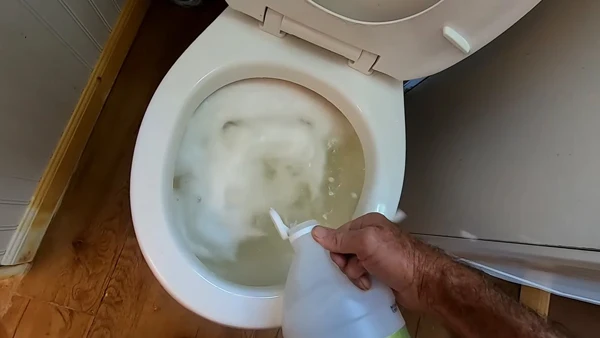
Chemical drain cleaners can be tempting for those looking for an easy solution to unclog their toilets. These cleaners can have severe consequences on the health of the user and the plumbing system:
Toxic Fumes and Chemical Burns
The chemicals in drain cleaners are corrosive and emit toxic fumes that are hazardous to breathe in. Furthermore, they can also cause skin burns if they come into contact with the skin.
Over an extended period, exposure to these fumes and chemicals could lead to more severe issues such as asthma or other respiratory problems. There is also the possibility of burning clothing or carpeting if the cleaner is not used correctly or comes into contact with them during use.
Can Damage Your Plumbing Pipes
Using chemical-based drain cleaners can damage metal and plastic pipes as they contain corrosive ingredients that weaken them over time. The harsh chemicals may start to eat away at your plumbing pipes due to their acidic nature leading to further blockages and leaks down the line.
When used with hot water, these chemicals can cause severe pipe deterioration, eventually requiring costly repairs or replacements.

May Contain Pollutants
Chemical-based drain cleaners often contain pollutants such as phosphorus, chlorine, and caustic soda released into waterways after being flushed down your toilet bowl or sink. These pollutants can:
- Disrupt aquatic ecosystems by killing plankton, plants, and fish
- Causing algal blooms
- Destroying coral reefs
- Contaminating drinking water supplies
- Poisoning our bodies over time due to bioaccumulation
So, you must take great care when using this product so that we do not harm our environment further than necessary.
What Drain Cleaner Should You Not Put Down a Toilet Drain?
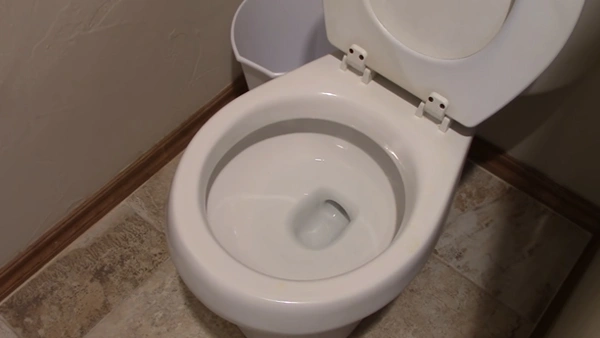
When choosing a drain cleaner for your toilet, the most important thing to remember is that you should never use an acid-based chemical cleaner. Acid-based cleaners can cause damage to the porcelain, rubber, and plastic components of your toilet and clog the drain. It can also corrode metal pipes, leading to costly repairs.
Instead of using an acid-based chemical cleaner, choosing a natural or biodegradable cleaner is best. Natural cleaners are safer for your plumbing system and the environment since they do not contain harsh chemicals that can harm plumbing fixtures or contaminate groundwater.
Biodegradable cleaners contain enzymes that help break down organic matter in the drains and pipes, which prevents clogs from forming.
Unclog With Caution: Clean Clogged Drains With Drain Cleaners
While it is possible to put drain cleaners in a toilet to unclog pipes, it is essential to remember that there are risks associated with this practice. Be sure to research the product type carefully you plan on using, as some types may not suit your particular situation.
Also, it’s best to consult a professional when dealing with severe blockages, as they have more experience in reliably resolving plumbing issues without risking damage to your fixtures or pipes.
With the right knowledge and proper safety precautions, you can efficiently solve your plumbing woes without worrying about possible harm from using products such as drain cleaners in your home’s toilets.

